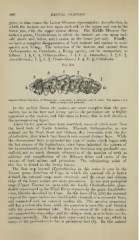Page 470 - My FlipBook
P. 470
480 DENTA L ANA TOMY. ,
genus in time comes the Lower Miocene representative Acerathenum, in
which the incisors are two upon each side in the upper and one in the
lower jaw, with the upper canine absent. The Middle Miocene fur-
nishes a genus, Ceratorhinus, in which the incisors are one upon each
side above and below, and a canine in the lower jaw only. Finally,
we have a complete disappearance of both incisors and canines in some
species now living. The reduction of the incisors and canines from
Orthocynodon to Coelodonta, a living species, can be summarized as
follows : I. C. Orthocynodon ; I. |, C. \, Amynodon ; I. \, C. f
I, I,
Acerathenum; I. {, C. , Ceratorhinus; I. ^, C. Coelodonta.
f f,
Fig. 258.
Superior Molar Dentition of lUiinoceros : «, anterior; 6, posterior end of series, The figures 1, 2, 3
indicate molars and premolars.
In the earliest forms the molars are more complex than the pre-
molars, but in the later and living species the premolars are as highly
organized as the molars, and like them in form ; this is well shown in
the accompanying figure.
About twelve genera have been described, seven of which come from
the fo.ssil beds of North America. Through Orthocynodon, as was
pointed out by Profs. Scott and Osborn, they inosculate with the Lo-
phiodoniidm, after which they branch into several distinct lines. While
the rhinoceroses have perpetuated the type of molar which began with
the la.st .section of the lophiodonts, other forms inherited the pattern of
the hyracotheroids, and from this ])()int tlie dentition was gradually .spe-
cialized, not so much through subtraction of the number of teeth as
addition and complication of the different lobes and crests of the
crowns of both molars and premolars. The culminating point of
this line is found in the living horses.
The first .step beyond Hyracotherinin in this series is seen in the
Eocene genus Ectoc'uvm of t/ope, in which the external rib is better
defined, the external cusps more crescentic, and the cusps and oblique
ridge of the lower molars are more prominent. In the next geological
stage (Upper Eocene) we meet with the family Challcotheri'idcB, abun-
dantly represented in the Wind River deposits by the genus Lamhdothe-
rium, likewi.se des(n-ibed by C^ope. In this form (Fig. 259) the external
cusps of tlie u[)|K!r molars are considerably elevated, of a crescentic form,
and connected with an external median rib. The anterior cro.s.s-crest
still has a tubercular form, while the posterior is cre.st-like and blended
with the postero-internal lobe. Tlie four cusps of the inferior molars
are connected by cro.ss-ridges and the oblique cre.st, .so as to form two Vs,
opening internally. The tooth here rej)resented is the la.st one, which in
many of the perissodactyls has a i)roimnent heel (A). In this animal


